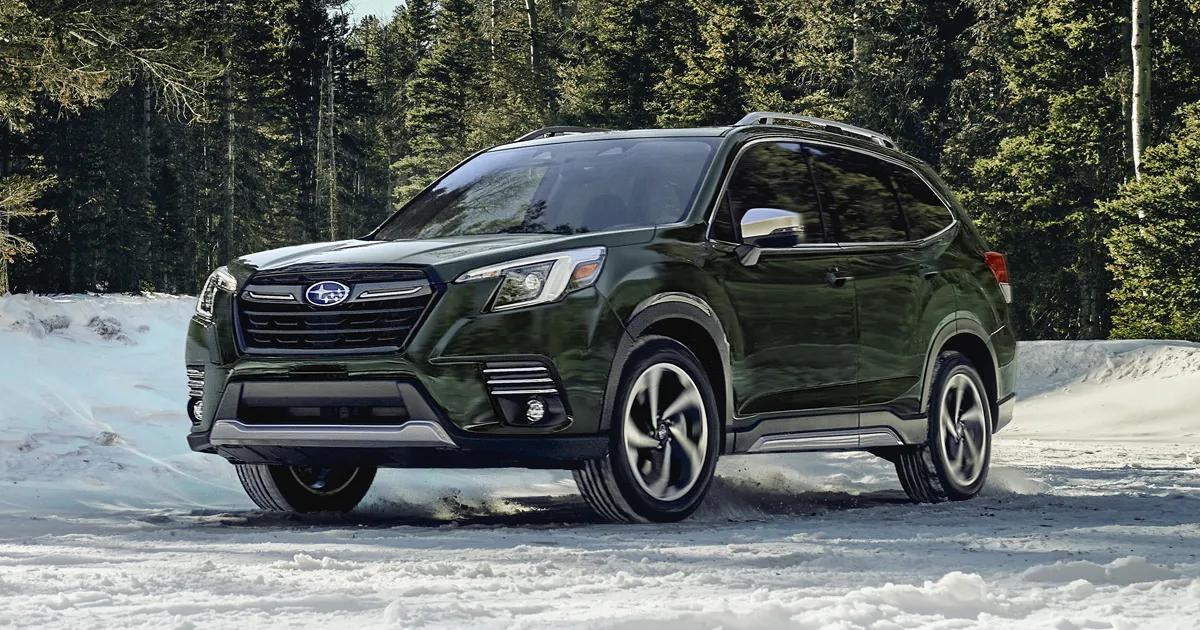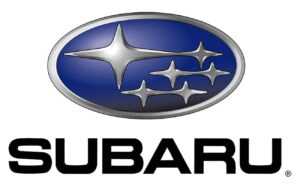Subaru Forester 2023 BSD/RCTA (if equipped) Base
Safety and awareness are very important in the 2023 Subaru Forester. The base trim level comes with the Rear Cross Traffic Alert (RCTA) and Blind Spot Detection BSD subaru systems as standard equipment. This dynamic pair of advanced safety technologies makes driving a lot more enjoyable by reducing possible blind spot hazards and providing important help when parking or backing out of tight spaces. The Rear Cross Traffic Alert system watches out for cars coming from either side when the driver is backing up. It uses sensors and radar to do this and gives the driver both audible and visible warnings to keep them from hitting something. At the same time, the Blind Spot Detection system keeps an eye on the roads next to the driver’s view and lets them know when there are cars in their blind spots by lighting up indicators in the side mirrors. This is another way that the Forester shows its dedication to safety and peace of mind on the road.
2023 Subaru Forester Specs, Price, Features, Mileage (Brochure)
BSD/RCTA (if equipped)
The BSD/RCTA subaru consists of rear corner radars with Blind Spot Detection and Rear Cross Traffic Alert.
These functions enable the system to detect objects or vehicles to the rear, drawing attention to the driver when changing a lane or when driving in reverse.
WARNING
The driver is responsible for driving safely. Always be sure to check the surroundings when changing lanes or reversing the vehicle.
The system is designed to assist the driver in changing lanes or reversing safely by monitoring the rear and side areas of the vehicle. However, you cannot rely on this system alone in assuring safety during a lane change or reversing. Overconfidence in this system could result in an accident and lead to serious injury or death. Since the system operation has various limitations, the flashing or illumination of the BSD/RCTA approach indicator light may be delayed or it may not operate at all even when a vehicle is present in a neighboring lane or approaching from either side.
The driver is responsible for paying attention to the rear and side areas of the vehicle.
System features
BSD RCTA Subaru consists of the following functions.
- To detect a vehicle in a blind spot on an
adjacent lane or a vehicle approaching at high speeds (Blind Spot Detection). . To detect a vehicle approaching from the right or left while reversing the vehicle (Rear Cross Traffic Alert).
The system uses radar sensors for the above functions.
NOTE
The Subaru BSD/RCTA radar sensor has been certified by the radio wave-related laws of the U.S. and Canada. When driving in other countries, certification of the country where the vehicle is driven must be obtained. For certification in the U.S. and Canada, refer to “Certification for the BSD/RCTA” P362.
Blind Spot Detection (BSD)
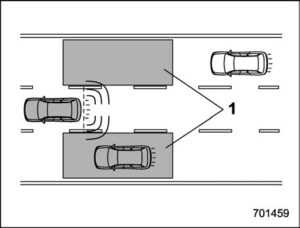
Operating range
The system warns the driver of dangers as follows.
If the system detects a vehicle in the blind spot, the BSD/RCTA approach indicator light(s) on the outside mirror (s) will illuminate.
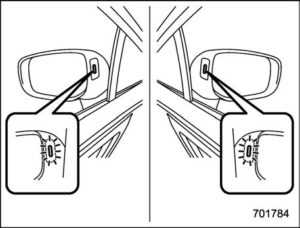
BSD/RCTA approach indicator light
- If the driver operates the turn signal lever in the direction which the BSD/RCTA approach indicator light is illuminating, the corresponding BSD/RCTA approach indicator light will flash.
Lane Change Assist (LCA)
Operating range
The system warns the driver of dangers as follows.
- If the system detects a vehicle approaching at a high speed in the neighbouring lanes, the Subaru BSD/RCTA approach indicator light(s) on the outside mirror(s) will illuminate.
- If the driver operates the turn signal lever in the direction in which the Subaru BSD RCTA approach indicator light is illuminating, the corresponding BSD/RCTA approach indicator light will flash.
Rear Cross Traffic Alert (RCTA)
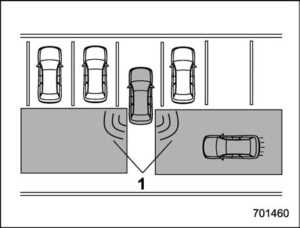
Operating range
The system notifies the driver of another vehicle approaching from either side when driving in reverse. This feature helps the driver check the rear and side areas of the vehicle when moving backwards.
If the system detects a vehicle approaching from either side while moving backwards, it warns the driver of dangers in the following way.
- The BSD/RCTA approach indicator light(s) on the outside mirror(s) flashes.
- A warning buzzer sounds.
- An icon appears on the rear view camera screen (audio/navigation monitor)
Limitations of the detectability of RCTA
Since the detectability of RCTA is limited, the RCTA may not operate properly in angled parking.
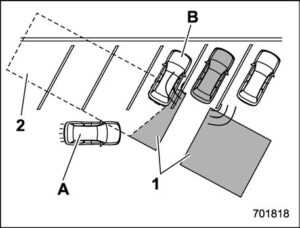
Example 1
- The detection range of the radar sensors
- Area out of detection range of the radar sensors
- Vehicle that may not be detected.
- Parked vehicle
WARNING
An approaching vehicle (A) may not be detected because the detection range is limited by the parked vehicle (B). Always be sure to check the surroundings when reversing the vehicle.
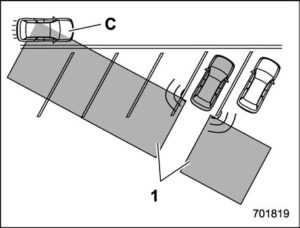
Example 2
- The detection range of the radar sensors
- A vehicle that may be detected
NOTE
The system may detect that a vehicle (C) is passing in front of your vehicle.
Always be sure to check the surroundings when reversing the vehicle.
System operation
Operating conditions
S07BM0201 The BSD/RCTA will operate when all of the following conditions are met.
- The BSD/RCTA will operate when all of the following conditions are met.
- The ignition switch is in the “ON” position.
- The BSD/RCTA warning light and BSD/ RCTA OFF indicator light are turned off. . The EyeSight warning indicator is off. . The vehicle is driven at speeds above 7 mph (12 km/h) (except when rever-sing).
- The select lever is in the “R” position (when reversing).
The BSD/RCTA will not operate in the following situations. - The BSD/RCTA OFF indicator light is on.
- The vehicle speed is below 6 mph (10 km/h) even when the BSD/RCTA OFF indicator light remains off (except when reversing).
NOTE
- In the following case, the BSD/RCTA will stop operating and the BSD/RCTA warning light will appear. If the BSD/RCTA warning light appears, have your vehicle inspected at a SUBARU dealer as soon as possible.
- When a malfunction occurs in the system, including the BSD/RCTA approach indicator light.
- In the following cases, the BSD/ RCTA will temporarily stop operating (or may stop operating) and the BSD/RCTA OFF indicator light will appear.
- When the radar sensor becomes significantly misaligned (If the orientation of the radar sensor is shifted for any reason, readjustment is required. Have the sensor adjusted at a SUBARU dealer.)
- When a large amount of snow or ice sticks to the rear bumper surface around the radar sensors.
- When the vehicle is driven on a snow-covered road or in an environment in which there are no objects around (such as in a desert) for a long time.
- When the temperature around the radar sensors increased excessively due to long driving on uphill grades in summer, etc.
- When the temperature around the radar sensors becomes extremely low.
– When the vehicle battery voltage lowers. - – When an overvoltage occurs in the vehicle battery.
When the above conditions are corrected, the BSD/RCTA will resume operation and the BSD/RCTA OFF indicator light will disappear. How-ever, if the BSD/RCTA OFF indicator light has appeared for a prolonged time, have the system inspected at a SUBARU dealer as soon as possible.
- The detectability of the radar sensors is restricted. The BSD/RCTA detection may be impaired and the system may not operate properly under the following conditions.
- When the rear bumper around the radar sensors is distorted.
- When ice, snow or mud adheres to the rear bumper surface around the radar sensors.
- When stickers, etc. are affixed on the areas of the radar sensors on the rear bumper.
- During adverse weather conditions such as rain, snow or fog
- When driving on wet roads such as snow-covered roads or through puddles
- The radar sensors may not detect or may have difficulty detecting the following.
- Small motorcycles, bicycles, pedestrians, stationary objects on the road or roadside, etc.
- Vehicles with body shapes that the radar may not reflect (vehicles with a low body height such as sports cars or a trailer with no cargo).
- Vehicles that are not approaching your vehicle even though they are in the detection area (either on a neighbouring lane to the rear or beside your vehicle when reversing). (The system determines the presence of approaching vehicles based on data detected by the radar sensors.)
- Vehicles travelling at significantly different speeds
- Vehicles driving parallel to your vehicle at almost the same speed for a prolonged time
- Oncoming vehicles
- Vehicles in a lane beyond the neighbouring lane
- Vehicles travelling at a significantly lower speed than you are trying to overtake
- On a road with extremely narrow lanes, the system may detect vehicles driving in a lane next to the neighbouring lane.
- When the 8-inch audio/navigation system is performing a software update, the RCTA warning icons may not be displayed on the audio/navigation screen until the update is complete.
BSD/RCTA approach indicator light/warning buzzer
When the BSD/RCTA is active, the BSD/RCTA approach indicator light will operate to alert the driver when there are vehicles in the neighbouring lanes. When reversing the vehicle, the BSD/RCTA approach indicator light and warning buzzer will operate to alert the driver that a vehicle is approaching from the left or right side.
BSD/RCTA approach indicator light

BSD/RCTA approach indicator light
It is mounted in each side of the outside mirrors.
The indicator light will illuminate when a vehicle approaching from behind is detected.
The indicator light will flash to warn the driver of dangers under the following conditions.
- While the indicator light illuminates, if you operate the turn signal lever toward the side in which this light turned on.
- When reversing the vehicle while the system detects a vehicle approaching from either side.
BSD/RCTA approach indicator light dimming function When the headlights are turned on, the brightness of the BSD/RCTA approach indicator light will be reduced.
NOTE
- You may have difficulty recognizing the BSD/RCTA approach indicator light under the following conditions.
- When affected by direct sunlight
- When affected by the headlight beams from the vehicles behind
- While the illumination brightness control dial is in the fully upward position, even if the headlights are turned on, the brightness of the BSD/RCTA approach indicator light will not be reduced. For details about the illumination brightness control dial, refer to “Illumination bright-ness control” P165.
BSD/RCTA approach warning buzzer (only when reversing)
A warning buzzer sounds along with flashing of the BSD/RCTA approach indicator light to warn the driver of dangers.
The setting of the warning buzzer volume can be changed by operating the combination meter display (color LCD). For details, refer to “Menu screens”P196.
Safety tips regarding the BSD/RCTA approach indicator light/warning buzzer
- In the following cases, the operation of the BSD/RCTA approach indicator light and the warning buzzer may be delayed or the system may fail to issue these warnings.
- When a vehicle moves to the neighbouring lane from a lane next to the neighbouring lane.
- When driving on a steep incline or on repeated sharp uphill and downhill grades
- When going beyond a pass
- When both your vehicle and a vehicle driving on a neighbouring lane are driving on the far side of each lane.
- When several narrowly spaced vehicles are approaching in a row.
- In low-radius bends (tight bends or when making turns at an intersection)
- When there is a difference in height between your lane and the neighbouring lane.
- Immediately after the BSD/RCTA is activated by pressing the BSD/RCTA OFF switch.
- Immediately after the select lever is shifted to the “R” position.
- When extremely heavy cargo is loaded in the cargo area.
- During reversing, the operation of the BSD/ RCTA approach indicator light and the warning buzzer may be delayed or the system may fail to issue these warnings under the following conditions.
- When backing out of an angled parking space
- When a large-sized vehicle is parked next to your vehicle. (That vehicle prevents the propagation of radar waves.)
- When reversing on sloped roads
- When reversing at a high speed

- The BSD/RCTA approach indicator light may illuminate when driving close to solid objects on the road or road side (such as guardrails, tunnels or side-walls).
- The BSD/RCTA approach indicator light may flash when turning at an intersection in urban areas or a multi-lane intersection.
- The BSD/RCTA approach indicator light may flash and the warning buzzer may sound if a building or a wall exists in the reversing direction.
- In the following cases, the system may detect a vehicle driving two lanes away from your vehicle.
- When you are driving on the near side of the lane of the corresponding vehicle.
- When the vehicle driving two lanes away is driving on the near side of its lane from your vehicle.
BSD/RCTA OFF indicator light
System temporary stop

- BSD/RCTA temporary stop message due to reduced radar sensitivity
- BSD/RCTA OFF indicator light
This display appears when the detectability of the radar sensors is reduced. Once the condition is corrected, the system will recover from the temporary stop condition and the indicator will disappear. If the indicator remains displayed for a pro-longed time, have the system inspected at a SUBARU dealer.
BSD/RCTA warning light
System malfunction
- BSD/RCTA malfunction message
- At first, this message will appear
- Then this message will appear
- BSD/RCTA warning light
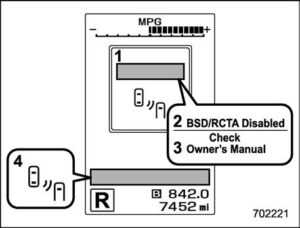
- BSD/RCTA malfunction message
- At first, this message will appear
- Then this message will appear
- BSD/RCTA warning light
This display appears when a malfunction occurs in the system. Contact a SUBARU dealer and have the system inspected.
BSD/RCTA OFF switch

BSD/RCTA OFF switch
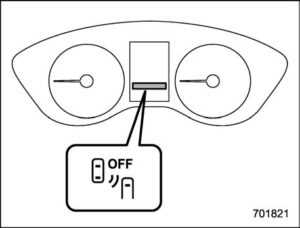
BSD/RCTA OFF indicator light
If the BSD/RCTA OFF switch is pressed, the BSD /RCTA OFF indicator light appears on the combination meter, and the BSD/RCTA is deactivated.
Press the switch again to activate the BSD/RCTA. The BSD/RCTA OFF indicator light will disappear.
When this occurs, the BSD/RCTA approach indicator light on the side of the rearview mirror illuminates for a few seconds and then turns off.
NOTE
- In the following cases, the system may not operate properly due to blocked radar waves. Press the BSD/RCTA OFF switch to deactivate the system.
When towing a trailer
When a bicycle carrier or other carrier item is fitted to the rear of the vehicle.
- When using a chassis dynamometer or free roller device, etc.
- When running the engine and making the wheels rotate while lifting up the vehicle ignition switch is turned to the “ON” position.
2023 Subaru Forester Specs, Price, Features, Mileage (Brochure)
Certification for the BSD/ RCTA
U.S.-spec. models
FCC ID: OAYSRR3A
CAUTION
FCC WARNING
Changes or modifications not expressly approved by the party responsible for compliance could void the user’s authority to operate the equipment.
NOTE
This device complies with part 15 of the FCC Rules. Operation is subject to the following two conditions:
- This device may not cause harmful interference, and
- This device must accept any interference received, including interference that may cause undesired operation.
Canada-spec. models
NOTE This device contains licence-exempt transmitter(s)/receiver(s) that comply with Innovation, Science and Economic Development Canada’s licence-exempt RSS(s). Operation is subject to the following two conditions:
- This device may no fuse interference.
- This device must accept any interference, including interference that may cause undesired operation of the device. Radiofrequency radiation exposure in formation: This equipment complies with radiation exposure limits set forth for an uncontrolled environment. This equipment should be installed and operated with minimum distance of 20 cm between the radiator and your body. 702692.
Handling of radar sensors
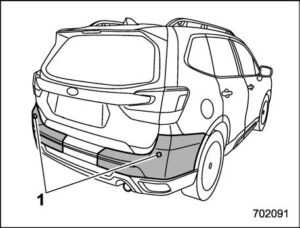
Sensors
The radar sensors, one on each side of the vehicle, are mounted inside the rear bumper.
To ensure correct operation of the BSD/RCTA, observe the following precautions. . Always keep the bumper surface near
the radar sensors clean.
- Do not affix any stickers or other items on the bumper surface near the radar sensors.
- Do not modify the bumper near the radar sensors.
- Do not paint the bumper near the radar sensors.
- Do not expose the bumper near the sensor becomes misaligned, a system malfunction may occur, including the inability to detect vehicles entering the detection areas. If any strong shock is applied to the bumper, be sure to contact your SUBARU dealer for inspection.
- Do not disassemble the radar sensors.
NOTE
If the radar sensors require repair or replacement, or the bumper area around the radar sensors requires repair, paintwork or replacement, contact your SUBARU dealer for assistance.
Reverse Automatic Braking (RAB) system (if equipped)
Reverse Automatic Braking (RAB) is a system designed to help avoid collisions or reduce collision damage when reversing the vehicle. If a wall or an obstacle is detected in the reversing direction, the system will notify the driver with a warning sound and may activate the vehicle’s brakes automatically.
WARNING
- Reverse Automatic Braking (RAB) is not a system intended to replace the driver’s responsibility to check surrounding areas for vehicles or obstacles to avoid a collision.
- The driver is responsible for driving safely. Before reversing, be sure to first depress the brake pedal and visually check the surroundings.
- There are some cases in which the vehicle cannot avoid collision, because the system operation has limitations. The warning sound or automatic braking may be delayed or may not operate at all even when an obstacle is present.
- The system is not designed to detect people (including children), animals or other moving objects.
- Depending on the vehicle condition or the surrounding environment, the sonar sensor’s ability to detect objects may be compromised.
- Do not remove the SUBARU genuine navigation and/or audio system. If the SUBARU genuine navigation and/or audio system is removed, the rear view camera image and help lines (distance marker, dynamic guidelines and vehicle width lines) will no longer be displayed.
- Even if the Reverse Automatic Braking (RAB) system and object detection warning is ON, the visible alert of Reverse Automatic Braking (RAB) system will not be displayed. However, the audible alert and its function will operate.
NOTE
The Reverse Automatic Braking (RAB) system records and stores the following data when automatic braking operates. It does not record conversations, personal information or other audio data.
- Distance from the object
- Vehicle speed
- Accelerator pedal operation status . Brake pedal operation status
- Select lever position
- Outside temperature
- The sensitivity setting of the sonar sensors
SUBARU and third parties contracted by SUBARU may acquire and use the recorded data for the purpose of vehicle research and development. SUBARU and third parties contracted by SUBARU will not disclose or provide the acquired data to any other third party except under the following conditions.
- The vehicle owner has given his/her consent.
- The disclosure/provision is based on a court order or other legally enforceable request.
- Data that has been modified so that identified is provided to a research institution for statistical processing or similar purposes.
Reverse Automatic Braking (RAB) system overview
The system detects objects using sonar sensors installed in the rear bumper.
- If the system determines a possible collision with an object in the reversing direction, automatic deceleration will be activated. Also, beeping sounds will activate.
- If the vehicle is further reversed, automatic hard braking will be applied and a continuous beeping sound will activate.
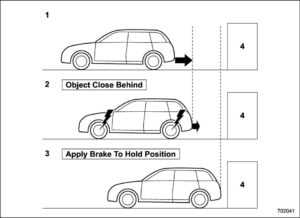
- When reversing
- When either strong automatic braking or torque control is applied to prevent collision (in this case, short warning beeps or continuous warning beeps will sound)
- When the vehicle is stopped by the system (in this case, the continuous beep will remain sounding)
- Object (e.g., a wall)
Detecting range

- Detecting range (width): Approximately 6in (15 cm) outside of the vehicle width
- Range that the system cannot detect:
Approximately 20 in (50 cm) behind the rear of the vehicle - Detecting range (length): Approximately 5 ft (1.5 m) from the rear of the vehicle
WARNING
If your vehicle is trapped on a railroad crossing and you are trying to escape by reversing through the crossing gate, the system may recognize the crossing gate as an obstacle and the brake may activate. In this case, remain calm and either continue to depress the accelerator pedal or cancel the system. To cancel the system, refer to “Canceling the Reverse Automatic Braking (RAB) system operation” P372.
Operating conditions
The Reverse Automatic Braking (RAB) system will operate when all of the following conditions are met.

- EyeSight warning indicator
- RAB warning indicator
- RAB OFF indicator
- The ignition switch is in the “ON” position.
- The EyeSight warning indicator is off. . The RAB warning indicator is off.
- The RAB OFF indicator is off.
- The Reverse Automatic Braking (RAB) system is set to on.
- The select lever is in the “R” position. . The vehicle speed is between 1 to 9 mph (1.5 to 15 km/h).
NOTE
- In the following cases, the Reverse Automatic Braking (RAB) system will not operate. Promptly contact a SUBARU dealer to have the system inspected.
- The EyeSight warning indicator is illuminated.
- The RAB warning indicator is illuminated.
- When the RAB OFF indicator is illuminated, the Reverse Automatic Braking (RAB) system cannot be operated.
- In the following cases, the system may not be able to properly detect an obstacle. Promptly contact a SUBARU dealer to have the system inspected.
- A sticker, paint, or a chemical is applied to the sonar sensor or the rear bumper near the sonar sensor.
- The rear bumper is modified.
- The rear bumper has been re-moved and reattached.
- The ground clearance is changed due to the vehicle’s loading condition or modification.
- Ice, snow or mud is adhered to the rear bumper near the sonar sensor.
- The rear bumper is exposed to strong impact, or the rear bumper is deformed.
- When the 8-inch audio/navigation system is performing a software update, the Reverse Automatic Braking (RAB) system may not display the following items on the audio/navigation screen until the update is complete.
- Display Icon on/off Function
- Distance Indicator Image
- Warning Message
- On a steep hill, the system’s automatic braking ability will be reduced. . The system is designed to avoid collisions by automatic hard braking when the vehicle’s reversing speed is less than approximately 3 mph (5 km/h). However, the system does not guarantee that the vehicle will be able to avoid collisions in any situation.
- If the vehicle is reversed at an extremely slow speed, the driver’s operation may be prioritized. In this case, automatic braking will not operate.
- The system may not be able to detect the following objects.
- Sharp or thin objects such as poles, fences and ropes which may not reflect the sound wave emitted from the sonar sensor.
- Objects that are too close to the rear bumper when the select lever is set to the “R” position.
- Objects with a surface which may not reflect the sound wave emitted from the sonar sensor such as a chain link fence.
- Objects the system is not designed to detect.
- Pedestrians
- Moving objects including moving vehicles
- Objects which absorb sound waves such as cloth or snow.
- Objects whose surface has a diagonal angle.
- Objects that are low to the ground such as parking blocks.
- Objects that are high above the ground such as objects hanging from above.
- Objects that are out of range of the center of the vehicle in the horizontal direction.
- Objects that are not perpendicular to the ground.
- The surface of the object is uneven or wavy.
- The system may not be able to properly detect objects or may cause a system malfunction when the following conditions exist.
High-frequency sound from other sources are nearby:- Horn sounds from other vehicles.
- Engine sounds from other vehicles.
- Sounds of air brakes
- Vehicle detection equipment or a sonar from other vehicles
- A sound wave with a frequency similar to the vehicle’s system is transmitted nearby.
- A vehicle equipped with the same system is reversing toward your reversing direction.
Weather conditions:
- Extremely high or extremely low temperatures in which the area near the sonar sensor becomes too hot or too cold to operate.
- The sonar sensors or the rear bumper near the sonar sensors is exposed to heavy rain or a significant amount of water.
- Fog, snow or sandstorms, etc.
- Air is moving rapidly such as when a strong wind is blowing.
Parts attached to the rear bumper near the sonar sensor:
- Commercial electronic parts (fog light, fender pole, radio antenna) or commercial attachment parts (trailer hitch, bicycle carrier, bumper guard) are attached.
- Parts that emit high-frequency sound, such as a horn or speaker, are attached.
2023 Subaru Forester Specs, Price, Features, Mileage (Brochure)
Vehicle conditions:
- The vehicle is significantly inclined.
- The ground clearance is significantly reduced due to the vehicle’s loading condition, etc.
- When the sonar sensor is misaligned due to a collision or an accident.
Surrounding environment:
- A cloth banner, flag, hanging branch or railroad crossing bars are present in the reversing direction.
- When reversing on a gravel or grassy area.
- When reversing in an area where objects or walls are adjacent to the vehicle such as narrow tunnels, narrow bridges, narrow roads or narrow garages.
- Wheel tracks or a hole is present in the ground of the reversing direction.
- When reversing over a drainage cover (grate cover).


- The path of the reversing direction is inclined such as on a steep uphill.
- A curb is present in the reversing direction.
- When reversing downhill.
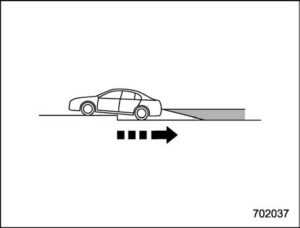
-
- When reversing on an uneven road.
- In circumstances such as the following, it may not be possible to avoid a collision even when the system operates normally.
- The roads are slippery.
- The tire air pressure is not correct.
- The tires have become worn.
- Tires which are not the designated size are installed.
- Emergency repairs were performed using a puncture repair kit.
- The suspension was modified.
- Tire chains are installed.
- Vehicle driving is unstable due to an accident or malfunction.
- The brake warning light is illuminated.
Reverse Automatic Braking (RAB) system operation
When the Reverse Automatic Braking (RAB) system is in operation, the range between the vehicle and the detected object will be indicated on the audio/navigation monitor. Also, warning sounds will activate in 3 levels to warn the driver of a potential collision.
While the RAB is operating, a warning message is displayed on the audio/navigation monitor and the combination meter display (color LCD).
Guideline of detecting range
| Alert level | Range of detected object* | Distance indicator | Alarm pattern |
| Long proximity alert (object detected) | 35 in (90 cm) or more | Green | No warning sound |
| Medium proximity alert (approaching the object) |
28 to 35 in (70 to 90 cm) |
Yellow |
Short beeps |
| Short proximity alert (approaching closer to the object) |
20 to 28 in (50 to 70 cm) |
Orange |
Rapid short beeps |
| Closest proximity alert (too close to the object) |
20 in (50 cm) or less |
Red |
Continuous beep |
Range of detection may vary depending on the environmental condition.
Obstacle detected and alert level

Long proximity alert (object detected)
- Green: 35 in (90 cm) or more
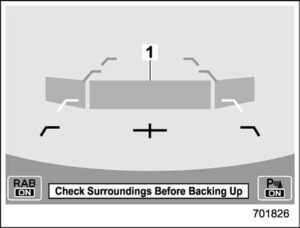
Medium proximity alert (approaching the object)
- Yellow: 28 to 35 in (70 to 90 cm)
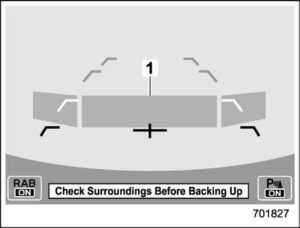
Short proximity alert (approaching the object closer)
- Orange: 20 to 28 in (50 to 70 cm)

Closest proximity alert (too close to the object)
- Red: 20 in (50 cm) or less When an object is detected in the reversing direction, the range of detected object will be shown on the audio/navigation monitor.
A warning alarm will sound and, depending on the speed, either torque control to generate engine braking or automatic braking will be applied.
Object close behind warning
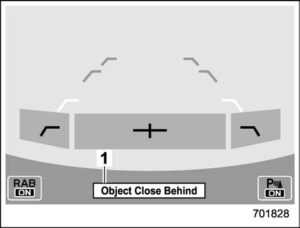
Automatic braking warning
- Warning message
If the vehicle continues to go in reverse, the system may determine the risk of collision with the object. In this case, short warning beeps or continuous warning beeps will sound and either strong automatic braking or torque control will be applied to prevent collision.
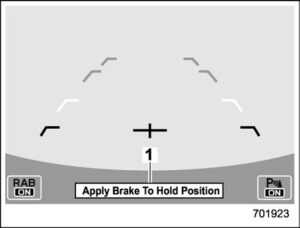
Depress brake pedal warning
- Warning message
Make sure to depress the brake pedal once the vehicle has been stopped by automatic braking. Until the brake pedal is depressed, a message will be displayed on the audio/navigation monitor and the continuous beep will remain sound. At this time, a warning message is also displayed on the combination meter display (color LCD).
NOTE
The Sonar Audible Alarm function and Automatic Braking function are different operation conditions. Therefore, there are cases in which only one of these functions will activate.
WARNING
Depress the brake pedal immediately after the system stops the vehicle by automatic braking. Depending on the conditions of the road surface and tires, the vehicle may not remain stopped, possibly leading to an unexpected accident.
After the vehicle is stopped by the system
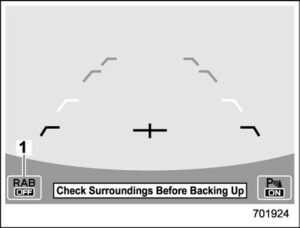
- RAB OFF indicator
After the brake pedal is depressed, the RAB OFF indicator will illuminate and the system will temporarily stop operating. The RAB OFF indicator will turn off when the select lever is shifted to a position other than the “R” position.
The system will operate again the next time the select lever is shifted to “R” position.
In circumstances such as the following, the Reverse Automatic Braking (RAB) system automatically stops operating and the RAB OFF indicator illuminates.
- There is ice, snow, mud, or other substance on the sonar sensors.
The select lever was shifted to “R” when there is an obstacle located close to the rear bumper. - A sound with a frequency close to that of the sonar used by the Reverse Automatic Braking (RAB) system was detected.
NOTE
- In the following cases, after the vehicle has been stopped by the Reverse Automatic Braking (RAB) system, brake control is released and the electronic parking brake operates. For details about releasing the parking brake, refer to “Electro-nic parking brake”P341.
- When 2 minutes pass after the vehicle is stopped.
- When any door is opened.
- When the EyeSight system malfunctions.
- When the Reverse Automatic Braking (RAB) system stops temporarily
- . The message/warning message will not display for approximately 8 seconds after turning the ignition switch to the “ON” position.
Cancelling the Reverse Automatic Braking (RAB) system operation
The Reverse Automatic Braking (RAB) system can be temporarily cancelled by any of the following operations.
- Depressing the brake pedal*
- Depressing the accelerator pedal*
- The accelerator pedal is kept depressed. (In this case, limited acceleration will be cancelled and the vehicle will continue reversing.)
- The select lever is shifted to a position other than the “R” position.
- While the vehicle is stopped by the automatic braking
NOTE
The system will be canceled if the object is no longer detected.
Reverse Automatic Braking (RAB) system ON/OFF setting
While the select lever is shifted to the “R” position, the below functions of the Re-verse Automatic Braking (RAB) system can be set by operating the audio/navigation monitor.

- ON setting key of Reverse Automatic Braking (RAB) system
- OFF setting key of Reverse Automatic Braking (RAB) system
- ON setting key of the object detection warning beeping sound
- OFF setting key of the object detection
warning beeping sound
When the ON setting key is shown, the corresponding setting is ON.
Touch and hold the ON setting key to turn the setting OFF
When the OFF setting is shown, the corresponding setting is OFF.
Touch and hold the OFF setting key to turn the setting ON.
When the Reverse Automatic Braking (RAB) system is turned OFF, the following indicator will illuminate.
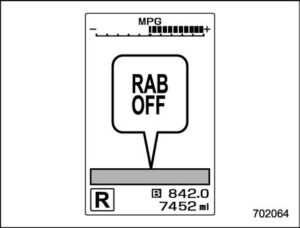
RAB OFF indicator: illuminates when the Reverse Automatic Braking (RAB) system is turned OFF.
RAB OFF indicator will turn off when the Reverse Automatic Braking (RAB) system is turned ON.
NOTE
- When the settings cannot be changed, the ON/OFF setting key will be grayed out.
- The ON/OFF setting key may be grayed out if the Reverse Automatic Braking (RAB) system malfunctions, etc. In this case, turn the ignition switch to the “OFF” position and then turn it to the “ON” position again. If the setting cannot be changed even after turning the ignition switch to the “ON” position again, consult your SUBARU dealer.
- The settings will be restored as follows when the select lever is shifted to the “R” position next time.
- Reverse Automatic Braking (RAB) system settings: default (ON setting)
Object detection warning beeping sound: the setting selected by operating the combination meter display (color LCD)
- Reverse Automatic Braking (RAB) system settings: default (ON setting)
Also, the following settings can be changed by operating the combination meter display (color LCD).
- Warning volume
- Sonar audible alarm ON/OFF
For details, refer to “Menu screens” P196.
RAB warning indicator

- RAB malfunction message
- RAB warning indicator
If the Reverse Automatic Braking (RAB) system malfunctions, the above indicator illuminates on the combination meter.
Contact the nearest SUBARU dealer for details.
Handling of the sonar sensors
S07BN06 The 4 sonar sensors are located in the rear bumper. To ensure the proper operation of the Reverse Automatic Braking (RAB)
the system, observe the following precautions.

- Do not affix any stickers or other items on the sonar sensor or the bumper surface near the sonar sensors.
- Always keep the rear bumper surface near the sonar sensors clean.
- Do not modify the rear bumper.
- Do not paint the bumper near the sonar sensors.
- Do not apply high-pressure water to the sonar sensors with a high-pressure car washing machine.
- Do not apply strong impacts to the rear bumper near the sonar sensors. If a sensor becomes misaligned, a system malfunction may occur, including inability to detect objects in the reversing direction. If any strong impact is applied to the rear bumper, contact a SUBARU dealer to have the system inspected.
- Do not disassemble the sonar sensors.
NOTE
If the sonar sensors require repair or replacement, or if the area of the rear bumper near the sonar sensors requires repair, paintwork or replacement, contact your SUBARU dealer for assistance.
FAQ
RCTA is a safety feature in the 2023 Subaru Forester that helps detect vehicles approaching from the sides when you’re backing up.
RCTA uses sensors and radar to monitor approaching vehicles’ movements and provides the driver with audible and visual warnings if a potential collision is detected.
BSD is a safety feature that monitors the vehicle’s blind spots, typically adjacent lanes on either side of your Forester.
BSD alerts the driver to the presence of vehicles in the blind spots by illuminating indicators in the side mirrors.
Yes, both RCTA and BSD are standard features on the base trim of the 2023 Subaru Forester.
Most vehicles with these features offer the option to disable or adjust the sensitivity of RCTA and BSD through the vehicle settings.
RCTA and BSD improve safety by reducing the risk of collisions when changing lanes or reversing out of parking spaces.
These systems are designed to work in various driving conditions, but their effectiveness may be influenced by factors like weather and visibility.
Yes, these systems have limitations and may not detect all vehicles or obstacles, so it’s essential to remain vigilant and use them as aids, not replacements for careful driving.
While these features can significantly reduce the risk of accidents, they cannot guarantee the prevention of all collisions, as they depend on various factors.
The base trim may include other safety features, such as adaptive cruise control and lane departure warning, but it’s best to consult the vehicle’s specifications for a complete list.
The integration of RCTA, BSD, and other safety features enhances overall vehicle safety by providing drivers with tools to help avoid accidents and navigate traffic more confidently.
Yes, higher trim levels of the 2023 Subaru Forester may offer additional safety features and technology packages that further enhance driver assistance and safety.
Using RCTA and BSD is generally straightforward, with warnings and indicators providing clear feedback to the driver, making them user-friendly.
You can refer to the vehicle’s owner’s manual or consult Subaru’s official website for comprehensive information about RCTA, BSD, and other safety features in the 2023 Subaru Forester.
Useful Link
View Full User Guide: Subaru Forester 2023 Base User Guide
Download Manuals: https://www.subaru.com/owners/vehicle-resources/manuals.htm
2023 Subaru Forester Specs, Price, Features, Mileage (Brochure)

